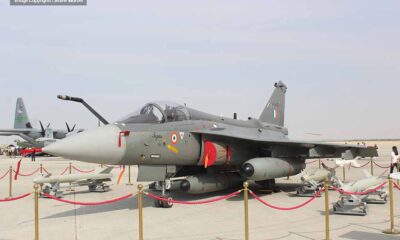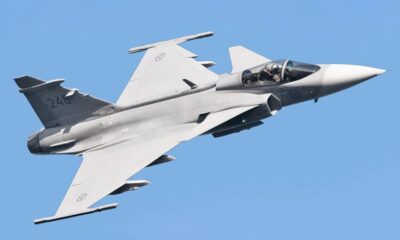Aerospace
Does Malaysia choose the Tejas fighter jet from India?

To improve its defence capabilities, Malaysia is looking for additional fighter aircraft. Since last year’s tender, the fighters are still being finalised. Many aerospace businesses from other countries applied for the contract; the top two were from Turkey and India, though the officials have not yet confirmed this.
Given its low acquisition cost and good technical ratings, India is the front-runner for Malaysia’s order of 18 Light Combat Aircraft (LCA). The offered package agreement also covers upkeep and spare parts for the country’s Sukhoi 30 fighter jets of Russian descent.
The pledge made by India to maintain Malaysia’s Sukhois in flight-ready condition is supported by the sizeable spares store and technical expertise of Hindustan Aeronautics Ltd (HAL).
South Korea and China are also vying for the contract, despite not having back-end agreements with Russian manufacturers to work on Sukhoi jets.
[the_ad id=”13562″]
-
Final decision will probably be made between governments.
Turkish Aerospace Industries (TAI) made the announcement that it is offering Malaysia joint production on a number of front-line military aircraft during the Defence Services Asia (DSA) 2022 expo in Kuala Lumpur. TAI’s Hürjet, which is under development, is submitted a bid for the Light Combat Aircraft/Fighter Lead-In-Trainer (LCA/FLIT) programme of the Royal Malaysian Air Force (RMAF).
The Malaysian Ministry of Defence (MoD) released a tender in June 2021 to fund the purchase of an initial 18 aircraft. Although it is still in development, the Hürjet will fly for the first time soon and the Turkish Air Force will get 16 of them starting in 2025. Hurjet might also go through testing that has been verified in flight, which might take longer. The Tejas aircraft, which were made in India, may deliver fighters in a 2 years, though, if the HAL secures a deal immediately.
The 19 Su 30 MKM fighters that Malaysia deploys are extremely similar to the Su MKI version that India uses.
According to the Economic Times, the dual package has been discussed, and a final decision will probably be made between governments.
Ordering spare parts and other supplies for outdated military equipment is becoming more and more challenging for a number of countries who possess Russian weapons.
-
Turkey’s Hurjet vs India’s Tejas
Hurjet is still in the development phase, whereas Tejas is already operational in the Indian air force. Tejas has a variety of offers for weapon packages, and since India has good diplomatic relations with other countries, some of its weapons have been jointly developed with foreign manufacturers. Hurjet is also offering some weapon packages, but they will be less in number than those offered by India’s HAL.
Tejas In order for Malaysia to improve its features with the HAL in the future, it is competing with other nations to release its Tejas Mark2 fighter, which is set to launch next year. China, Korea, and Russia all made offers to Malaysia. HAL Tejas is more inexpensive in their country when compared to other nations because of its price.
Spain orders 20 Eurofighter jets.(Opens in a new browser tab)
-
India offer Updates Radar and Avionics
A contemporary AESA radar, updated avionics, and the potential to incorporate a variety of air to air to ground weapons are all included in the LCA that India is offering to Malaysia.
Astra air-to-air missiles with a range beyond optical range have also been ordered by the Indian Navy and Air Force.
Teams from Malaysia visited India to examine the LCA offer, and to assure better servicing, the Indian side offered to build up an overhaul facility for the LCA fleet in Malaysia.
The India LCA costs $42 million; the cheap price has been made possible by economies of scale after the Indian Air Force ordered 83 of these jets as part of the Make in India programme.
[the_ad id=”13559″]
India’s offers to maintain Malaysia’s Sukhoi 30 fighter with HAL expertise and currently available Russian spare parts are open to India, but it maintains that doing so will result in more powerful defence fleet for Malaysia and a successful deal for both nations. Tejas fighter jet offers India’s strength which lies mostly in its arsenal of aircraft and weapons, which has elevated it to the top of Malaysia’s list of priorities. And even under the new contract, it can provide LCA and Dhrvua helicopter.
There are several indications that Malaysia may choose the Tejas for its defence squad, however Malaysia has not yet officially released it.

Aerospace
Indigo will soon launch Air Taxi Service in India

InterGlobe Enterprises, the parent brand of IndiGo, is set to revolutionize travel in India with its upcoming air taxi service.
Scheduled for a potential launch in 2026, this innovative venture promises a seamless journey for passengers between two bustling hubs. Delhi and Gurgaon in Haryana. The forthcoming service is projected to revolutionize the daily commute, offering passengers a swift aerial journey covering the distance in a mere 7 minutes.
This remarkable efficiency contrasts starkly with the conventional 90-minute drive, underscoring the immense time-saving potential for commuters. The anticipated fare, ranging from Rs 2,000-3,000, makes this innovative mode of transport not only swift but also remarkably competitive in pricing.
At the heart of this ambitious endeavor lies a strategic partnership with Archer Aviation, a pioneer in electric vertical takeoff and landing (eVTOL) aircraft technology. Under this collaboration, Archer will supply 200 state-of-the-art eVTOL aircraft, representing an investment of US$ 1 billion. These cutting-edge aircraft, capable of accommodating up to four passengers alongside the pilot, epitomize the future of sustainable air travel.
Powered by six battery packs, Archer’s eVTOL aircraft boast rapid charging capabilities, enabling a swift turnaround between flights. With a charging time of just 30-40 minutes, these eco-friendly aircraft ensure minimal downtime, maximizing operational efficiency.
Similar services are anticipated to be introduced by the joint venture in Bengaluru and Mumbai as well. Nevertheless, the service rollout period has not yet been made public by the company. Next year, it is anticipated to get its certification. Following this, the company will start the certification procedure with the Directorate General of Civil Aviation (DGCA).
Aerospace
Which is bigger 777x or 787 aircraft ?

The 777X is a new series of the Boeing 777 family and is designed to be larger and more efficient than its predecessor. It features two variants: the 777-8 and the 777-9, being the larger of the two.
The Boeing 777X emerges as the larger sibling within the Boeing family, representing a significant leap forward in both size and efficiency. Comprising two variants, the 777-8 and the 777-9, the latter takes the crown as the larger of the two. With its expansive fuselage and impressive wingspan, the 777X is tailored for long-range journeys and boasts a substantial passenger capacity.
On the other hand, the Boeing 787, affectionately known as the Dreamliner, occupies a niche in the market as a smaller yet formidable aircraft designed for medium to long-range flights. Its distinguishing feature lies in its composite fuselage, a technological marvel that renders it lighter and more fuel-efficient compared to conventional aluminum counterparts. The Boeing 777X is larger than the Boeing 787 aircraft.
When it comes to passenger capacity, the 777-9 reigns supreme, typically accommodating a sizeable contingent of 400-425 passengers in its standard configuration. In contrast, the 787, with its more modest dimensions, typically carries between 240-290 passengers, depending on the variant and layout.
One of the remarkable innovations introduced with the 777X is its folding wingtips, a feature designed to address the logistical challenges of accommodating such a large aircraft in conventional airport gates. These folding wingtips enable the 777X to retract its wings, allowing it to fit into gates designed for smaller aircraft while still reaping the benefits of an extended wingspan during flight, thereby enhancing fuel efficiency and operational flexibility
Aerospace
China Secures Production Certificate for Mass Production of Pilotless eVTOL Aircraft

The first passenger-carrying pilotless electric vertical takeoff and landing (eVTOL) aircraft in the world, the EH216-S, has received the Production Certificate for its eVTOL aircraft from the Civil Aviation Administration of China (CAAC).
This is a significant milestone for EHang Holdings Limited, the leading UAM technology platform company in the world. This outstanding accomplishment is another big step towards mass manufacturing for the eVTOL aircraft and the ensuing commercial operations, building on the ground-breaking acquisition of the Type Certificate and the Standard Airworthiness Certificate for the EH216-S.
The PC is a crucial certificate that the aircraft maker receives from the CAAC, the country’s aviation authority. By obtaining this certificate, EHang has demonstrated that it has set up a quality management system for mass production that satisfies the airworthiness regulation standards set forth by the CAAC, and the company has been given permission to continue producing mass quantities.
It is also a strong guarantee of the calibre of the goods made by EHang. Raw materials, supplier management, manufacturing organisation, production quality control, aircraft pre-delivery test, after-sales repair and maintenance, etc. are all included in the mass production quality management system for the EH216-S.
To ensure that every aircraft and its components that roll off the production line strictly adhere to the approved type design and safety requirements, the system sets clear guidelines and documentation for every step in the production procedure. This ensures comprehensive traceability and safety control.




























